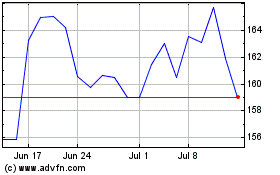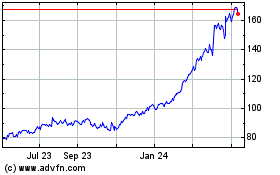GE Posts Weak Industrial Results, Predicts Second-Half Rebound--2nd Update
July 22 2016 - 10:14AM
Dow Jones News
By Ted Mann
General Electric Co. reported weak quarterly profit and revenue
in its core industrial business, weighed down by its oil equipment
division, but executives predicted demand would improve the second
half of the year.
Industrial orders -- a key measure of future demand for GE's jet
engines, power turbines and oil production equipment -- fell 16% in
the second quarter, excluding recent acquisitions. Despite a 1%
decline in organic industrial revenue in the first half of the
year, executives stuck by their target of 2% to 4% growth for the
year.
"Bottom line, we are seeing organic growth accelerating in the
second half," Chief Executive Jeff Immelt said on a conference call
Friday. While the company's oil and gas and transportation
businesses are in "tough cycles," he said, the outlook for the
global economy "is no better, no worse" than earlier in the year
and "85% of our company is in great shape."
GE shares, up more than 20% over the past year, fell 3% in
premarket trading.
The heaviest drag on GE's performance continues to be its oil
and gas equipment business, which has struggled since oil drillers
and producers slashed capital spending amid the long-term slump in
crude oil prices.
The company said that a surge of shipments of power turbines
would help drive revenue growth in the second half of the year.
"The environment remains very, very tough," Chief Financial
Officer Jeffrey Bornstein said, as the number of active rigs and
wells continues to shrink. Mr. Immelt said he saw no likelihood
that the oil outlook would improve in 2017.
Oil & Gas revenue fell 22% and profit dropped 48% in the
quarter, and orders fell 34% compared with last year. GE said it is
continuing to target $800 million of cost-cutting in the oil
business for the year to offset falling revenues and profits.
Overall for the period ended June 30, GE reported a profit of
$2.74 billion, or 36 cents a share, compared with a loss of $1.36
billion, or 17 cents a share, a year earlier.
Revenue rose to $33.49 billion from $29.23 billion. The revenue
was boosted by last year's acquisition of Alstom's power business,
which contributed $3.2 billion in the quarter.
Excluding the finance businesses being wound down, GE reported a
profit of 51 cents a share, while revenue came in at $24.4
billion.
GE said its industrial profit slipped 5.4% to $4.1 billion in
the quarter.
Last month, the conglomerate's lending arm, GE Capital,
successfully shed its designation as a "systemically important"
financial institution -- a label that had required the company to
submit to stricter rules and supervision by the Federal Reserve --
after months of shedding assets of the business, long seen as a
distraction by investors who believed it dragged on the company's
share price.
GE said Friday that the GE Capital exit plan has enabled it to
return $15 billion in dividends year to date, and the company's
de-designation as a systemically important financial institution
gives it more balance sheet flexibility.
In addition, the parent company borrowed $5 billion from GE
Capital in the second quarter, using the money to help fund the
company's accelerated share buyback program. "This makes a ton of
sense for the company," Mr. Bornstein said.
"We will continue to invest in key growth initiatives such as GE
Digital, while returning [about] $26 billion to investors through
buyback and dividends," Mr. Immelt said.
--Anne Steele contributed to this article.
Write to Ted Mann at ted.mann@wsj.com
(END) Dow Jones Newswires
July 22, 2016 09:59 ET (13:59 GMT)
Copyright (c) 2016 Dow Jones & Company, Inc.
GE Aerospace (NYSE:GE)
Historical Stock Chart
From Mar 2024 to Apr 2024

GE Aerospace (NYSE:GE)
Historical Stock Chart
From Apr 2023 to Apr 2024
